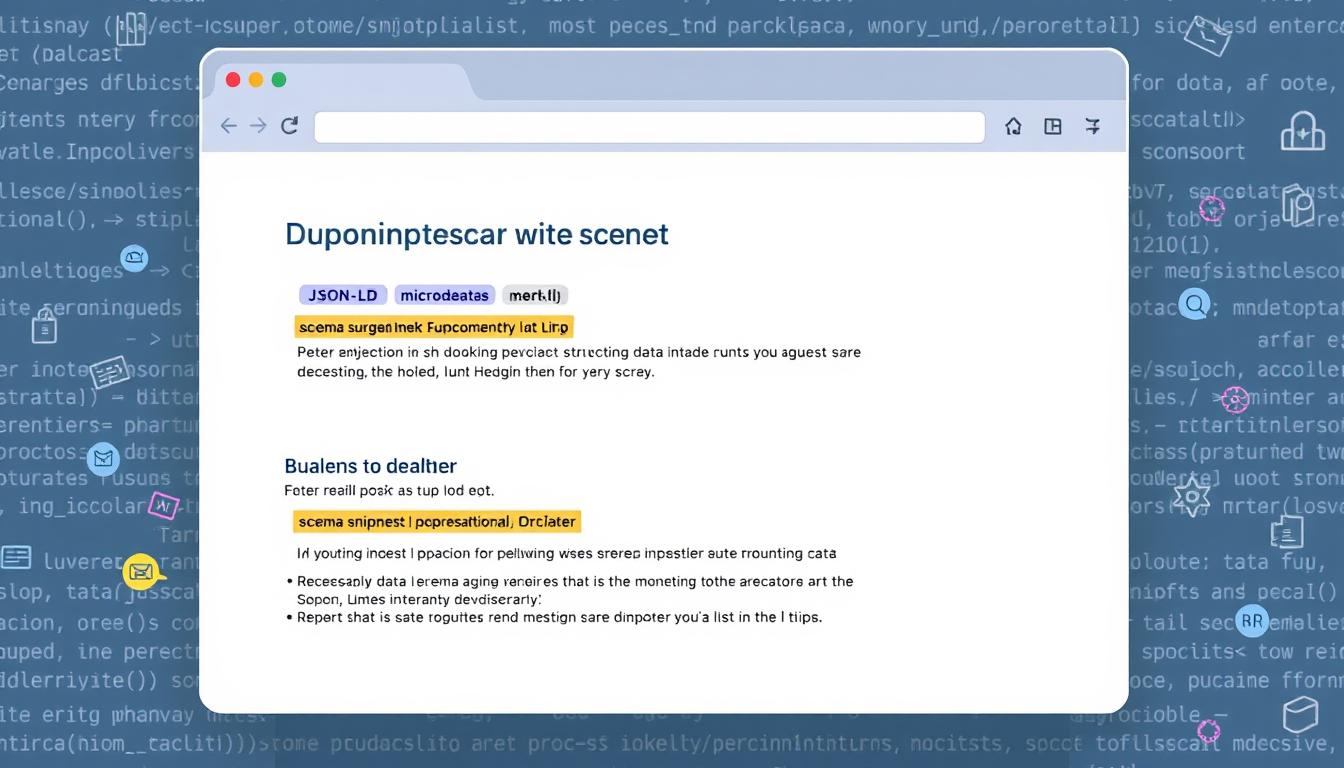|
Getting your Trinity Audio player ready...
|
Ever wonder why some search results stand out with eye-catching details? It’s not magic—it’s schema markup. By adding schema markup for rich snippets, you’re giving search engines a roadmap to your content. This helps them understand your website better, which can boost your visibility in search results.
Rich snippet optimization is like giving your website a megaphone in the crowded digital space. It makes your content stand out in search engine results pages (SERPs). Using structured data markup improves your site’s look and boosts its chances of grabbing users’ attention and driving more clicks.
Ready to dive into the world of schema markup? Let’s explore how this powerful tool can transform your online presence and give your SEO efforts a significant boost.
Understanding Schema Markup and Rich Snippets
Schema markup and rich snippets are key to making your website more visible in search results. Let’s explore how they work together to boost your online presence.
What is schema markup?
Schema.org markup is a special kind of markup that helps search engines get your content. It’s a structured data vocabulary you add to your HTML. This extra info lets search engines show more detailed results to users.
The importance of rich snippets in search results
Rich snippets are enhanced search results that show more than just the usual title, URL, and description. They can include ratings, prices, and availability. These detailed results can lead to more clicks, boosting your SEO and driving more traffic to your site.
How schema and rich snippets work together
Schema markup and rich snippets are a team. When you add schema.org markup to your site, you give search engines the data they need for rich snippets. This partnership makes your content stand out in search results, encouraging more clicks.
The Benefits of Using Schema Markup for Rich Snippets

Schema markup for rich snippets brings many benefits to your website’s SEO. It helps you stand out in search engine results pages (SERPs). This makes your site more visible and competitive.
Rich snippets SEO boosts your click-through rates. When your search listing shows extra details like ratings or prices, more people click on it. This shows search engines that your content is valuable and relevant.
Structured data markup also helps you show up in featured snippets and knowledge graph entries. These top spots in search results can bring more organic traffic. They make your site a trusted source in your field.
Schema markup also improves the user experience. Rich snippets give a quick summary of your content. This helps users find what they need faster. It can lead to lower bounce rates and more time spent on your site, both good for search engines.
Using rich snippets SEO benefits both search engines and your users. This approach can lead to better rankings, more visibility, and more conversions for your business.
Common Types of Schema Markup for Rich Snippets
Schema markup is key for rich snippet optimization. Let’s look at the most common schema.org markup types for better search results.
Organization Schema
Organization schema helps search engines get your company’s details. You can add your business name, logo, and contact info. This markup boosts your search result visibility and builds trust with customers.
Local Business Schema
Local businesses need local business schema. It lets you share your address, phone number, and hours. This markup can help you show up in local searches and Google Maps.
Product Schema
E-commerce sites benefit from product schema. You can show product details like price, availability, and ratings. This can increase click-through rates from search results.
Review Schema
Review schema lets you show customer feedback in search results. With this markup, you can display star ratings and reviews. This can sway potential customers’ choices.
Event Schema
Event schema is great for event organizers or promoters. It helps search engines understand event details like dates and locations. This markup can make your event more visible in search results and event listings.
Getting Started with Schema.org

Schema.org is your top choice for adding schema markup to your website. It’s a project that helps your site show up better in search results. Start by visiting Schema.org to see all the options for structured data markup.
Look through the different schema types available. You’ll find ones for products, events, and more. Each type has detailed guides on how to use it. It’s important to understand the structure of schemas to pick the right ones for your site.
When you’re ready to add schema markup, Schema.org has examples in JSON-LD, Microdata, and RDFa. JSON-LD is often recommended for its simplicity. Use the examples as a guide to create effective structured data for your pages.
Getting schema right takes care and precision. Make sure your markup has all the necessary properties and is formatted correctly. With practice, you’ll get better at using Schema.org to improve your site’s search visibility.
Choosing the Right Schema Markup for Your Content
Choosing the right schema markup is key for better search results. It’s about analyzing and implementing carefully to make your site more visible.
Analyzing Your Website Content
First, look at what your site offers. Do you have products, events, or local info? Knowing this helps pick the best schema.org markup. It’s the first step to making your site more search-friendly.
Matching Content Types to Appropriate Schema
After identifying your content, match it with the right schema. Use Product schema for online stores or Event schema for webinars. This ensures search engines get your content right, helping you show up in rich snippets.
Prioritizing Schema Implementation
With limited resources, focus on what matters most. Start with pages that get a lot of traffic or are key for sales. This way, you get the most out of your efforts, improving your site’s performance.
Tools for Generating and Testing Schema Markup

Creating and checking schema markup is easy with the right tools. Google’s Structured Data Markup Helper is perfect for beginners. It helps you add rich snippets HTML to your web pages. Just enter your URL, pick the content type, and highlight the important parts on your page.
For a more hands-on experience, try Schema Markup Generator. It has many options for adding schema data to your site. You can make custom markup for articles, products, and events. It’s simple to get the code and put it on your site.
After adding structured data markup, it’s important to test it. Google’s Rich Results Test is a great tool for this. It checks if your schema is correct and if it can show rich snippets in search results. Just enter your URL or paste your code, and it will give you feedback on your markup.
These tools make adding schema markup easy, even for those who don’t code much. By using these resources, you can make your website more visible in search results. This improves your SEO strategy.
Implementing Schema Markup for Rich Snippets: Step-by-Step Guide
Adding schema markup to your site can make it more visible in search results. This guide will help you through the process. You’ll learn how to make the most of your rich snippets HTML.
Selecting the appropriate schema type
First, figure out what’s on your page. Is it a product, review, or event? Pick the schema type that fits your content best. This is key for good schema data integration.
Creating the markup code
After choosing the right schema, create the markup code. Use Schema.org as your guide. Write it in JSON-LD format. It’s simpler to use and less likely to have mistakes.
Adding markup to your website
Now, add the markup to your site. Put the JSON-LD script in the head section of your HTML. If you’re using a CMS, you might need to edit theme files or use a plugin for this.
Validating your implementation
After adding the markup, validate it. Use Google’s Rich Results Test tool to check if it’s correct. This tool shows how your rich snippets will look in search results and points out any mistakes.
By following these steps, you’ll successfully add schema markup for rich snippets. Remember, good schema data integration can really help your site show up better in search engines.
Best Practices for Schema Markup Implementation
Getting the most out of rich snippets starts with good schema markup. To get the best search engine results, follow these important steps. They help you add structured data to your site effectively.
Make sure your schema is the same everywhere on your website. Use the same format for similar content types. This makes it easier for search engines to show your info right.
Keep your markup up to date. When your content changes, update your schema too. Old data can lead to wrong rich snippets, which can hurt your SEO.
Implement schema wisely, especially for big sites. Use templates or tools to add it fast. This keeps things consistent and saves time.
Always follow search engine rules for structured data. Each platform has its own rules. Following these increases your chances of getting great rich results in search listings.
Test your markup well before it goes live. Use tools to find and fix errors. Good testing stops problems that keep your rich snippets from showing up.
By following these tips, you’ll do better with your rich snippet optimization. You’ll also get more visibility in search engine results. Remember, keeping your schema markup up to date is a continuous job that needs regular attention.
Common Mistakes to Avoid When Adding Schema Markup
When you add schema.org markup for rich snippets SEO, it’s key to avoid common mistakes. Steer clear of these errors to make your semantic markup work better. This will also boost your search engine visibility.
Over-optimization and spam
Don’t overdo it with schema markup. Too much can harm your efforts. Stick to adding relevant information that really adds value to your content. Remember, quality is more important than quantity for rich snippets SEO.
Incorrect property usage
Using the wrong properties in your schema.org markup can confuse search engines. It’s important to know what each property is for and use it right. For instance, don’t use “price” for a blog post or “articleBody” for a product page.
Inconsistent information
Your schema markup should match what’s on your page. If it doesn’t, you could face penalties. Always check that your semantic markup matches what users see on your site.
Avoiding these common schema markup mistakes will help you create better rich snippets SEO. This way, search engines will understand your content better. They’ll also show it accurately in search results.
Measuring the Impact of Schema Markup on Your SEO
It’s key to track how well your rich snippets SEO is doing. By checking the results of your structured data markup, you can make your strategy even better. This will help improve your search engine rankings.
First, watch your click-through rates (CTR) in Google Search Console. See if pages with schema markup get more clicks than those without. If they do, it means your rich snippets are working well.
Then, look at your organic search traffic. Check if more people visit your site when you use structured data markup. This shows if your rich snippets are bringing in more visitors.
Also, keep an eye on your keyword rankings. If they go up after adding schema, it’s a sign that search engines get your content better.
Use Google’s Rich Results Test to make sure your markup is working right. This helps avoid any technical problems that might mess up your efforts.
Remember, the effects of schema markup take time to show. Be patient and keep tracking regularly. By doing this, you’ll learn a lot about how well your rich snippets SEO is working.
Advanced Schema Markup Techniques for Enhanced Rich Snippets
Want to make your rich snippets stand out? Advanced schema markup can do just that. It helps create search results that really catch the eye.
Nested schemas are a great way to add depth to your data. You can put one schema inside another. For instance, you can nest a Product schema in an Offer schema. This makes your product and its price details shine in search results.
Custom properties are another key to better rich snippets. Schema.org lets you create unique properties for your content. This way, you can highlight special features that standard properties might miss.
Using multiple schema types can make your content shine in search results. Mixing schemas like Product, Review, and Offer gives a complete view of your content. This advanced method can make your search results more informative and attractive, possibly increasing clicks.

